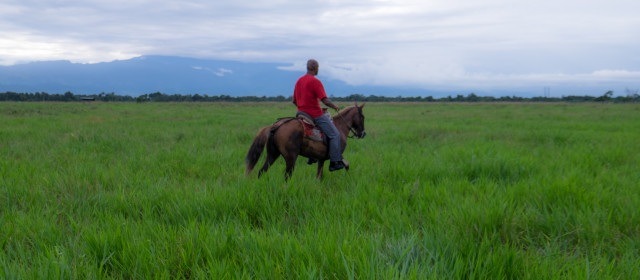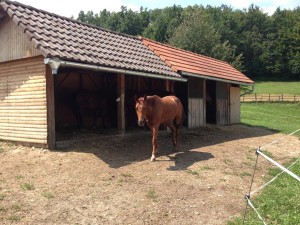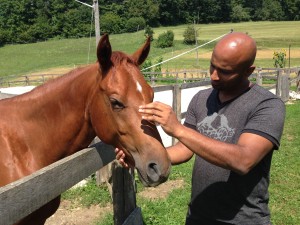Graceful Canters, Airy Trots, Wisps of mane waving in the wind, Steam lightly blown from nostrils, The sheen of sweat glistening across flexing muscles. These are just some of the pictures that conjure up in my mind every time I think of horses. Those magnificent beasts of the plain. So powerful, and yet so gentle. Horses evoke strong emotions. Freedom. Power. Love. Grace….
On our trip around the world, I encountered horses in a few places. On a friend’s farm in Slovenia, On a trail in Peru, On the mountains of Vilcabamba, and on the vast grasslands of Los Llanos, Colombia.
The first couple meetings were purely by chance. Slowly but surely, however, I began to fall in love with these gentle creatures. I began to actively seek out opportunities to learn about and experience horses.
This blog is as much a chronicle as it is a love story.
It all started when I went to visit my friends Marko and Veronica in Slovenia. At the time they were staying the Marko’s uncle on his farm in the east of Slovenia, close to Krsko. There I met Marko’s cousins Tina and Katja. Tina was taking care of the horses on the farm, and knew a lot about them. She graciously offered to teach me to ride.
We saddled up one of the horses, a mare, and I got my first couple lessons in Horse Riding.
Here were a few of the first things I learnt:
- Horses are very sensitive to emotions. They can feel what you are feeling. If you are nervous, so will the horse be. Be tranquil, and so will the horse (easier said than done!)
- A horse hates tentativeness: Give simple clear directions to the horse and he listens. Be watery and you get punished. I had a hard time with this initially as we will see.
How to Ride a Horse
You direct a horse using two things. Your legs and the reins.
To go: Depending on how the horse was trained this could be a few things. Kick them on the sides with your feet, loosen the reins or yell out something (like “Ha!” or “Vamos” if you’re in Colombia or perhaps “Tally-Ho!” if you’re living in a Jane Austen novel)
To Stop: Pretty universal. Pull the reins in. I have also seen the South americans use shushing sounds to get them to slow down and stop. Interesting aside. The spanish word for reins is ‘frenos’ which also means brakes. Makes sense as they are used as brakes. But not entirely correct as you also use them to turn. In car you don’t use brakes to turn unless you’re drifting, but I’m drifting from the point.
To Turn: As I said above, use the reins. Tug them right to go right and left for the other way. My friend Stacey who used to be a competitive barrel racer at rodeos (and is now a Pastor of a church. Go figure!) tells me that in her part of the world they also use the legs to steer the horses by pressing into their sides obliquely. It also takes away from needing to use pressure on their mouths with the reins.
Armed with my newfound knowledge, I clambered on top of the black mare. And soon found myself hopelessly lost at sea. The horse was having none of its new wannabe rider. What I realized only later was that I was then doing exactly what Tina had told me not to… be tentative, and it was pissing the horse off. I was worried about startling it or being too rough, fearing that the horse would simply rear up on its handles and throw me off! Hence I was being very ‘gentle’. Or at least I thought I was being gentle. I would gently nudge it to go left. The horse, having sensed that I was a complete newbie, would not move the first time. And I would think, ok perhaps it doesn’t want to go left. Let me try asking it to go right. I would politely tug the reins to the right. The horse must have been thinking ‘Make up your mind buddy!’, for all I got the horse to do was to shake its head madly and stomp it’s legs. That got me scared, which agitated the horse even more. A bad bad start to the cycle. Thankfully, Tina came to my rescue and told me to be more firm. If I want to go left, I needed to tell it to go left firmly, and keep telling it till it listened. ‘You need to show that you are the master, else she will sense that you don’t know what you’re doing and do whatever she pleases.’.
I took a deep breath. ‘Fake it till you make it, fake it till you make it’.
I mustered up all the courage I could and yelled ‘Ha!’, pulling the reins to the left with more force than I thought it needed. The result was amazing. The horse quieted down and ambled to the left. Success! My first successful communication with a horse! More confident now, I began to walk it forward, having it go left then right then left again. Each time I gave a decisive signal the horse listened. Each time I wavered before telling her, she flat out ignored me. It was quite the lesson.
Soon I was getting the horse to go any which way I wanted. The next step was to try a trot. Tina had mentioned that all I needed to do was to gently kick its sides. I did that, and the horse accelerated. For those of you who have never been on a horse, a trot is the most painful position to be on for the rider.
When a horse is walking, it moves slow, gentle and you the rider waddles on top. It’s like being in a giant Cadillac. A gallop, when the horse is running all out, is surprisingly also comfortable, because the body of the horse, and you on it, settle into this smooth, slow rhythm. A trot however, is like sitting inside the engine of my grandfathers rusty Plymouth with all shock absorbers removed. It will jar your bones. I know. I had spent about 3 hours of a 5 hour horse ride in Vilcabamba trotting, and I needed the whole of the next day to just lie in bed and recuperate! It’s like being inside the martini shaker of 007’s bartender. It’s like being an ant sitting on the snare drum of Metallica. You don’t want to be there for too long.
Seeing my plight, Tina suggested that I kick it again to get it to gallop. I tried it, and instantly regretted it. The jarring slowed down all right. Only to be replaced with complete and utter dread as the horse took off in all it’s glory and I was left holding on for dear life, visions of being trampled rushing through my head. I could take it for all of two seconds before I felt myself dangerously leaning off to one side. Thankfully, I had the presence of mind to yank the reins to get the horse to stop. I got off, shaking, wondering how the hell someone does it. Tina got on and galloped around the perimeter, moving gracefully along with the horse. She made it look so easy. A feat I could not copy. Not even close. The two seconds of galloping was all I could manage each and every time before I felt I was earning a quick pass to the nearest hospital.
The sun was setting. Thanking Tina, I dismounted and bade goodbye to the magnificent creature that had let me use it to gain my first few stumbling footholds into horse riding.
Continued on Horse Riding in South America…








Recent Comments